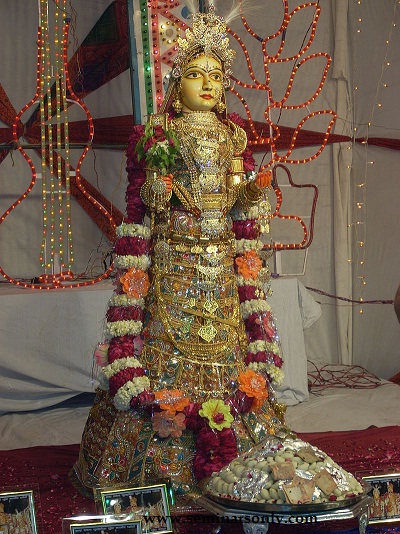





Published on Apr 15, 2021
Gangaur Teej Pooja Vidhi : Gangaur is a festival celebrated in the Indian state of Rajasthan and some parts of Gujarat, Madhya Pradesh, and West Bengal. Gangaur is colorful and one of the most important festivals of people of Rajasthan and is observed throughout the state with great fervour and devotion by womenfolk who worship Gauri, the wife of Lord Shiva during March–April.
Gangaur Teej 2021 Date is on 15th April 2021
It is the celebration of spring, harvest, marital fidelity, and childbearing
Gana is a synonym for Lord Shiva and Gaur which stands for Gauri or Parvati who symbolizes Saubhagya (marital bliss). The unmarried women worship her for being blessed with a good husband, while married women do so for the welfare, health, and long life of their husbands and for a happy married life. People from Rajasthan when migrated to Kolkata in West Bengal started celebrating Gangaur. This celebration is now more than 100 years old in Kolkata. The 2021 date for the festival is 15 April

1. खम्मा घणी सा
गणगौर रे रंग बिरंगे पारंपरिक तिंवार री आप सबनैं घणी घणी बधायां, भगवान ईसर गोर आपां सगळा रे ऊपर सूं महामारी रा बदरा बेगा हटाय।
या बार आपां ने घर रे मांय स्वयं ही माटी सूं गणगौर बणार पूजण करनो है अर ध्याण रहवे की भीड़ भाड़ री जिसी स्थिति कोनी बने। घर रे मांय ही जद सगळा कुंबा मिलर गुणा बनावेला तो बि में स्वाद भी घणो आवेगो।
।। जय ईसर गोर ।।
2. व्रत गणगौर का है बहुत ही मधुर प्यार का
दिल की श्रद्धा और सच्चे विश्वास का
बिछियां पैरों में हो माथे पर बिंदिया
हर जन्म में मिलन हो हमारा पिया
गणगौर की हार्दिक शुभकामनायें
3. चंदन की खुशबू, फागुन की बहार
आप सभी को मुबारक हो गणगौर का त्यौहार
4. आया रे आया गणगौर का त्यौहार है आया
संग में खुशियां और प्यार है लाया
गणगौर की ढेर सारी शुभकामनायें
5. माँ पार्वती आप पर अपनी कृपा हमेशा बनाए रखे
आपको गणगौर की हार्दिक शुभकामनायें
6. गणगौर है उमंगो का त्यौहार
फूल खिले है बागों में फागुन की है फुहार
दिल से आप सब को हो मुबारक
प्यारा ये गणगौर का त्यौहार
7. हाँजी म्हारे आँगन कुओ खिनयदो हिवड़ा इतरो पानी
हाँजी जुड़ो खोलर न्हावा बेठी ईश्वरजी री रानी
हाँजी झाल झलके झुमना रल के बोले इमरत बानी
हाँजी इमरत का दो प्याला भरिया कंकुरी पिगानी
8. ऊंचो चोड्यो चोखण नो जल,
जमुना रो नीर मंगावो जी राज,
जखे ईश्वर तापेड़ियां बाकी राण्या ने गौर पूजाओ जी राज।
गौर पूजन ता लूकेबे शायह या जोड़ी अबछल रखो जी राज,
सदाचल राखो जी राज।
The ladies decorate their hands and feet by drawing designs with Mehndi (myrtle paste). The figures drawn range from the Sun, Moon and the starts to simple flowers or geometrical designs. Ghudlias are earthen pots with numerous holes all around and a lamp lit inside them. On the evening of the 7th day after Holi, unmarried girls go around singing songs of ghudlia carrying the pots with a burning lamp inside, on their heads. On their way, they collect small presents of cash, sweets, jaggery, ghee, oil etc. this continues for 10 days i.e. up to the conclusion of the Gangaur festival when the girls break their pots and throw the debris into the well or a tank and enjoys a feast with the collection made
Once upon a time, Lord Shiv, along Goddess Parvati and Narad Muni went out to take a small trip. When they reached a nearby forest, the news of their arrival spread like wild fire. As the women were busy preparing a gorgeous spread for the Gods and Goddess, the women of the low class came with their offerings. Lord Shiv and Goddess Parvati happily ate the food and Goddess sprinkled the "suhagras" on them.
After a certain time, the women of the high classes came with the food they had prepared. When they had finished eating Lord Shiv asked his wife that with what was she going to bless the women as she had already finished every bit of the "suhagras" on blessing the women of lower classes. To this, Goddess Parvati replied that she intended to bless these women with her own blood. Saying so, she scratched the tip of her finger and sprinkled the blood on these women.
The festival reaches its climax during the last three days. The images of Gauri and Isar are dressed in new garments especially made for the occasion. Unmarried girls and married women decorate the images and make them look like living figures.
At an auspicious hour in the afternoon, a procession is taken out to a garden, bawdi or johad or well with the images of Isar and Gauri, placed on the heads of married women. Songs are sung about the departure of Gauri to her husband's house. The procession comes back after offering water to the first two days. On the final day, she faces in the same direction as Isar and the procession concludes in the consignment of the all images in the waters of a tank or a well. The women bid farewell to Gauri and turn their eyes and the Gangaur festival comes to an end.
No one has commented yet. Be the first!